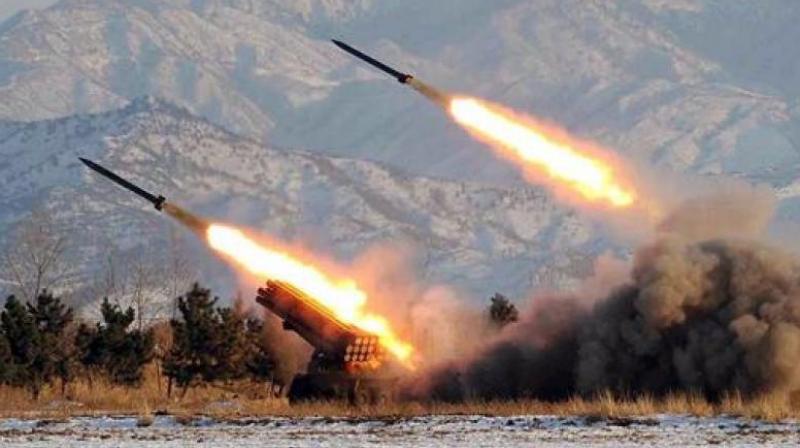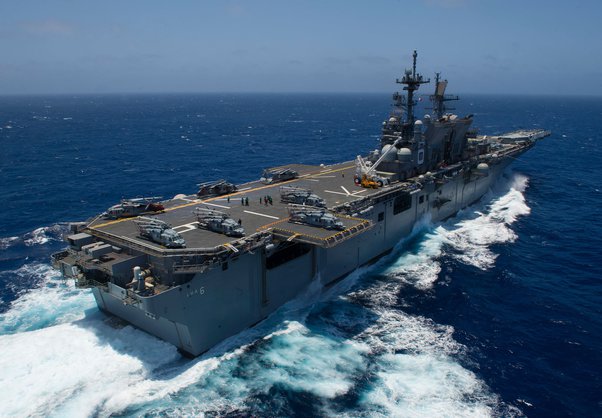IAF is seen extensively in carrying out HADR (Humanitarian Assistance in Disaster Relief) missions, within and outside the country, which not only gets praised for its highly professional work but also reinforces the importance of its operational capabilities. IAF’s arm of advanced Transport aircraft like C-17, C-130 and its Helicopter fleet of Chinooks and Mi-17 V5, have been discharging its strategic and tactical HADR roles respectively in a commendable manner. Even while this article is being written, the IAF is busy providing HADR support in Myanmar & Thailand post the recent deadly earthquake. However, the primary role of IAF, being the security of India’s airspace, has to be mainly ensured through an effective fleet of advanced fighter aircraft. With its depleting fighter squadrons, unstable neighbourhood, unpredictable world order and induction of 5th generation Chinese J-20 and J-35 stealth fighter aircraft on its northern borders, the alarm bells have started ringing towards India’s national & regional aerospace security.
To handle a two-front war, IAF is sanctioned a strength of 42 squadrons of fighter aircraft fleet; however, due to the phasing out of an aging fleet of MiG-21, MiG-23 & MiG-27, delayed procurement and delayed indigenisation, the fleet strength has depleted to just around 30 squadrons. The depletion in the fighter squadron strength is quite alarming for two reasons. Firstly, acquisitions take a long time due to availability, cost concerns, and indecision both at the service HQ/ MoD and secondly, the fast upgradation of advanced fighters in our northern and western neighbourhood.
Lost decades for IAF ….The aging Mig-21 fleet, being the largest component of IAF’s fighter fleet and the vintage Jaguar/Mig-29 fleet were planned to be replaced with a mix of LCA, MMRCA and MRFA programme of local production as well as foreign acquisitions. MMRCA (Medium Multi Role Combat Aircraft) programme of acquiring 126 aircraft dragged on for years and finally it was cancelled in 2014, post acquisition of 36 Rafale aircraft (2 Squadrons) from France. The emergency acquisition of 02 squadrons should have been followed up with faster decision making in acquiring more Rafale squadrons through direct purchase or local production, but it never happened. Orders with HAL for the supply of LCA MK1 & MK2 have been extremely slow and way behind schedule, thereby complicating matters further.
HAL’s LCA programme…This project was conceived and started in 1983 to meet the future requirements of the IAF & Indian Navy’s fighter aircraft. It’s a project designed by DRDO’s ADA (Aeronautical Development Agency) and manufactured by HAL (Hindustan Aeronautics Limited). LCA made its first flight in 2001 and entered into service in 2015. In due course, IAF ordered 40 LCA MK1 and 83 MK1A but both supplies have been extremely behind schedule. HAL has delivered 2 Squadrons of LCA MK1 but MK1A has been extremely delayed, primarily due to the USA’s GE company not supplying the contracted number of Engines in the last more than two years. GE has just begun supplying engines with its 1st delivery recently, which gives some hope of the start of LCA MK 1A aircraft to IAF in the near future however, dependency on foreign collaborators for the engines would continue to be a big limiting factor till India attains self-sufficiency in this sector too.
Fighters on offer for the IAF …..India’s fighter procurement strategy could be a mix of indigenous capabilities and foreign collaborations. IAF is quite familiar with the major fighter aircraft producing companies of the world since its previous evaluation experience for the MMRCA project. Rafale, Grippen, Eurofighter, apart from Russian MIG & Sukhoi, have been delt by IAF in the past. As per the news reports, the front runners appear to be French Rafale, American F-35 and Russian SU-57, the last two even participated in the just concluded Aero-India show at Bengaluru. A look at the techno-economic-strategic aspect of the three may help us in the better understanding of its selection for the IAF.
Rafale F4, a 4.5th gen fighter, with its earlier variant of two squadrons already in service in the IAF, becomes an automatic choice as part of India’s quest for its MRFA. It’s known for its agility and maneuverability with large payloads. It is considered more cost-effective with lower operating and maintenance costs in comparison to the F-35. Rafale offers full sovereign control over its operational parameters in comparison to F-35; however, how far the French govt willing to transfer its technology for the Make-in-India initiative needs more clarity. Also, with Chinese 5th gen fighters already in India’s neighbourhood, is the IAF and the govt of India willing to go in for a 4.5th gen Rafale variant or stick to the existing Rafale, which will be in service for the next 3-4 decades.
F-35, a 5th gen multi-role, offensive strike fighter, is a single-seat, single-engine (Prat & Whitney F135-PW-100 afterburning turbofan), stealth fighter aircraft with three variants. It can achieve a max speed of Mach 1.6 with a range of approx. 2200 kms. It’s equipped with advanced sensors, including an AESA (Active Electronically Scanned Array) radar and AI-driven combat systems. It has seamless data sharing capabilities. F-35A, a conventional take-off and landing for the Air Force, F-35B, short field take-off and vertical landing for the Marine Corps and F-35C for the Navy. As of this date, the US manufacturer Lockheed Martin has already delivered more than 1000 F-35s worldwide, including USAF. F-35 has the advantage of a large global supply chain and extensive NATO interoperability. F-35s have proven their operational capabilities in the ongoing conflict in the Middle-East however, what may be of concern to India may be its exorbitant cost (approx. 80-110 million US $), tech transfer for its local production and American reliability in times of crisis due to complex software integration and strict U.S export control regulations.
Su-57, a reported 5th gen twin-engine (Saturn AL41F1 afterburning turbofan), Russian defensive, air superiority, partial stealth fighter because of reduced radar signature. It can attain a max speed of Mach 2 with approx. max range of 3000 km. It’s highly maneuverable due to its twin engines & thrust-vectoring engines. It is also equipped with a multi-band radar suite, including L-band for stealth detection. SU-57 is expected to be cost-effective (35-40 million US$) in comparison to the F-35s. The most favourable aspect for India could be Russian reliability in crisis, operational familiarity and economical cost with no operational limitations.
The different scenarios to address the shortages could be a mix of indigenous developments and international partnerships. The roadmap could be as follows-
Scenario a. 114 Rafale aircraft from France as part of the proposed MRFA (Multi Role Fighter Aircraft) programme, along with indigenous development of AMCA (Advanced Medium Combat Aircraft). The Rafale, a 4.5 generation fighter already with the IAF, offers proven multi-role capabilities with nuclear deterrence. This could be the most preferred path due to IAF’s familiarity in terms of tech, logistics and training. The purchase of these many Rafales would amount to about 5 squadrons, which would take care of the immediate shortfall in squadron strength. The purchase cost of these many Rafales could be an issue but with such large orders, India would be in a commanding position to leverage its strategic partnership with France, at the same time making a huge business sense to the French government. Additionally, India can continue with its indigenous stealth, 5th generation AMCA development programme. India’s DRDO (Defence Research & Development Organisation), responsible for the development of AMCA, must fast-track this development by a judicious mix of Indian Public/Private companies as well as foreign friendly collaborations. This approach would be a time-tested one, considering French reliability at the same time, avoiding American unreliability at the time of crisis and fostering the development of indigenous advanced fighter capabilities.
Scenario b. Keeping in sync with the enhanced Indo-USA strategic partnership, India could go in for its immediate MRFA need with US F-15EX, a 4.5 generation heavy fighter with advanced avionics, large payload and long-range strike potential, at the same time continue with accelerated AMCA development for the 5th gen fighter programme. This scenario balances India’s immediate fighter shortages along with its interoperability with QUAD partners like the USA, Japan & Australia.
Scenario c. This could be a Russian option which is time-tested but, of late witnessed inconsistent delivery schedules and cost overruns. India could meet its MRFA requirement through Russian Su-35 or MiG-35, along with a few squadrons of Su-57, a reported 5th gen fighter. This option may ensure affordability, familiarity and timely delivery, but with concerns of US sanctions.
A combination of the above measures is likely to ensure the following: a. Immediate induction of at least 02 squadrons of existing Rafale fighters. b. Commencement of MRFA class fighters by 2027-28 to ensure the raising of 5-6 squadrons by 2032. c. Freeze LCA Mk2 design in 2025 to start production by 2028-29 to have 06 squadrons by 2035 as a replacement for Jaguars/MiG-29. d. Priorities AMCA development to have 1st flight in 2028-29 and serial production by 2032-33. e. Secure foreign collaborations for engines & stealth tech at the earliest. f. Aim to start production of AMCA by 2035 to have approximately. 5 squadrons by 2040. g. In the interim, upgrade the entire fleet of Su-30 MkI with AESA radar, EW suites & Astra MK2 missiles. h. Strengthen Force Multipliers like combat drones, AEWs, AWACs & Refuellers.
Recommendations- In order to arrest and augment the falling fighter strength of IAF by putting in place a few institutional mechanisms in place, the following measures need to be taken at the earliest.
- Decision making at the PMO level to avoid further bureaucratic delays in facilitating early delivery of MRFA and AMCA class of fighters to IAF. PMO also needs to look at the inability of GTRE to produce the required engines for our fighter development programme and fix it without any further delay. Restore the HAL leadership to a senior IAF aviator to bring synergy and urgency among different arms of HAL, as is the case with Naval officers heading Shipyards.
- Speed and efficiency in production/procurement- scale up HAL production of LCA MK1 & MK2 and go in for G2G for MRFA & FGFA programme.
- Private Sector Investment- Encourage HAL/TATA/L&T/Adani/ Godrej/Kirloskar to tie-up with India’s strategic partner firms like Dassault/ GE/BAE, etc, to expedite MRFA & FGFA programmes. Private sector involvement in developing cutting-edge aerospace tech like stealth and engines is the crying need of the hour.
- Minimise Fighter Diversity- This would help in the easy supply/ maintenance & training requirements, thereby facilitating better serviceability status of the fighter fleet.
- Freezing of Design Specifications- IAF to freeze LCA MK2 & AMCA design specifications at the earliest so as to facilitate its early prototype delivery.
- Adequate Budgetary Support- MoD must ensure timely enhanced capital layout for the MRFA & AMCA acquisition programme.
Conclusion….As discussed above, various options appear to be available on the table; however, what is of prime importance is an immediate intervention at the PMO level in selecting 114 MRFA, either French, Russian, American or European, to arrest & augment the grave slide in the total number of effective Fighter squadrons. Secondly, accelerated delivery of LCA (Tejas) MK1 & MK2 to IAF by overcoming roadblocks like engine & production scaling up. Thirdly, accelerated development of AMCA with a suitable engine and stealth tech needs to be tied up immediately with domestic as well as foreign collaborators to meet IAF’s 5th gen fighter requirement, latest by 2035. This has also attained urgency given the Chinese J-20 & J-35 challenge in its immediate neighbourhood, as well as to establish India as an indigenous Aerospace power shortly. One school of thought may suggest going in for foreign fighters, both for MRFA and 5th gen in place of AMCA, considering the past poor track record of indigenous fighter development programme however, that won’t be in the long-term interest of the country because the nation’s security can only be ensured with indigenous capabilities. In no case should IAF and the MoD repeat their mistake of 60s when it abandoned its indigenous HF Marut fighter development programme and went in for foreign aircraft, thereby missing the indigenous development of fighters completely. IAF leadership need to be clear in putting up their case to MoD wrt MRFA & FGFA (AMCA) and pursue them relentlessly irrespective of the change in guard over time. Lastly, our top Politico-Beaurocratic leadership needs to keep in mind that no price can be too high for the insurance of our national security …. Jai Hind.
















